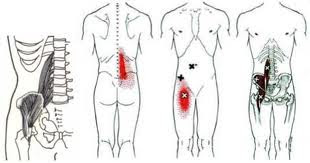The rectus abdominus = the 6-pack that we all want, strive for and drool over. But tightness/overuse of this show pony muscle can be driving lower back pain.
The rectus abdominus is a broad, flat muscle that runs vertical on the wall of the front of the abdomen. It extends from the pubic symphysis, pubic crest and pubic tubercle to the xyphoid process and costal cartilages of the 5th to 7th ribs. This muscle is important posturally; it’s actions include flexing the lumbar spine (like when doing a sit-up), posteriorly tilting the pelvis and assisting in hip flexion. It also assists with breathing, as in forceful expiration (breathing out), keeping the internal organs intact and creating internal abdominal pressure.
Trigger points or tight spots in the lower rectus abdominus have been found to refer pain into the lower back – like a thick band of pain around the lower back and into the top of the glutes. Trigger points higher up near the ribs have been found to refer pain higher up in the back, closer towards the bottom of the scapula.
 |
| A. Trigger points in rectus abdominus and their referral pattern in the mid/lower back.
It is important to note that if you have tightness in your rectus abdominus, your iliopsoas (long hip flexor) is most likely going to be tight also.
|
 |
Trigger points in iliopsoas and referral pattern in lower back and front of hip/thigh.
If you are suffering from lower back pain, try releasing both your rectus abdominus and iliopsoas. Lie on with a lacrosse ball, baseball or softball under your abdomen, off to the side, about a fist length away from the belly button. Contract/relax your abs as you lie on the ball and make sure to move it up/down the length of your abs.
Another method is to get a heavy kettlebell and place the handle lengthways or crossways under your tummy. Then get on all fours and jam the handle of the kettlebell into your stomach, trying to find any tender/tight spots. Contract/relax your abs as you need to.
This is a highly unpleasant and somewhat interesting position to be in; I was told that it’s referred to as the “Kettlebell Hump” because that’s what it looks like when you’re doing it….but it is very effective. (Thanks Antony Lo – The PhysioDetective for this one!!!)
Maybe try it in private first….and good luck.
|


